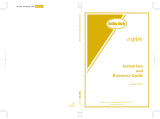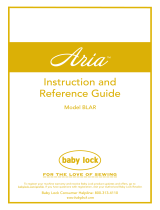
1 —
2 —
3 —
4 —
5 —
6 —
7 —
8 —
?
!
9 —
CONTENTS
Index
■
Overcasting (Using a Zigzag Stitch)
3-20
■ Appliqué (Using a Zigzag Stitch) .. 3-21
■ Patchwork (for Crazy Quilt) .......... 3-21
■
Sewing Curves
(Using a Zigzag Stitch) ...................
3-21
Elastic Zigzag Stitches ......................... 3-22
■ Tape Attaching ............................. 3-22
■ Overcasting .................................. 3-22
Overcasting......................................... 3-23
■
Overcasting Using Presser Foot “G”
3-23
■ Overcasting Using Presser Foot “J” 3-24
■ Overcasting Using the Side Cutter 3-25
Quilting .............................................. 3-28
■ Piecing ......................................... 3-29
■ Quilting........................................ 3-30
■ Appliqué ...................................... 3-31
■ Quilting with Satin Stitches .......... 3-33
Blind Hem Stitches.............................. 3-35
■
If the Needle Does not Catch the
Fold ...............................................
3-36
■ If the Needle Catches Too Much
of the Fold.................................... 3-36
Appliqué............................................. 3-37
■ Sewing Sharp Curves .................... 3-38
Shelltuck Stitches ................................ 3-39
Scallop Stitches................................... 3-41
Patchwork Stitches.............................. 3-42
Smocking Stitches ............................... 3-44
Fagoting.............................................. 3-46
Tape or Elastic Attaching ..................... 3-47
Heirloom ............................................ 3-49
■ Hemstitching (1) (Daisy stitch) ...... 3-49
■ Hemstitching (2) (Drawn work) .... 3-50
■ Hemstitching (3) ........................... 3-52
Buttonholes......................................... 3-53
■ Sewing Stretch Fabrics.................. 3-56
■
Odd Shaped Buttons/Buttons that do
not Fit into the Button Holder Plate..
3-56
Darning............................................... 3-57
Bar Tacks ............................................ 3-59
Button Sewing..................................... 3-61
■ Attaching 4 Hole Buttons ............. 3-62
■ Attaching a Shank to the Button ... 3-63
Eyelet.................................................. 3-63
Multi-directional Sewing
(Straight Stitch and Zigzag Stitch) ........ 3-65
Zipper Insertion................................... 3-67
■ Centered Zipper ........................... 3-67
■ Inserting a Side Zipper.................. 3-68
Chapter 4 Sewing Character/
Decorative Stitches
SELECTING A STITCH PATTERN .......... 4-1
Decorative Stitch Patterns ..................... 4-2
7mm Decorative Stitch Patterns ............ 4-3
Satin Stitch Patterns............................... 4-3
7mm Satin Stitch Patterns...................... 4-4
Cross Stitch ........................................... 4-4
Utility Decorative Stitch Patterns........... 4-5
Alphabetical Characters ........................ 4-6
■ If You Make a Mistake Selecting the
Character ....................................... 4-7
SEWING CHARACTER/DECORATIVE
STITCH PATTERNS ............................... 4-8
Sewing Attractive Finishes..................... 4-8
Basic Sewing of Character/
Decorative Stitches ............................... 4-9
Making Stitch Pattern Adjustments .......4-11
EDITING CHARACTER/DECORATIVE
STITCH PATTERNS ............................. 4-13
■ Key Functions............................... 4-14
Changing the Size of the Stitch Patterns .
4-15
Changing the Stitch Pattern Length
(for 7mm Satin Stitch Patterns Only).... 4-16
Creating a Vertical Mirror Image ......... 4-16
Creating a Horizontal Mirror Image..... 4-16
Sewing Pattern Continuously............... 4-17
■
When Sewing the Pattern Continuously
4-17
■ When Sewing Single Stitches........ 4-17
COMBINING STITCH PATTERNS....... 4-18
Before Combining Stitch Patterns ........ 4-18
Combining Decorative Stitch and
Character Stitch Patterns ..................... 4-18
Combining Large and Small Stitch
Patterns............................................... 4-20
Combining Horizontal Mirror Image
Stitch Patterns ..................................... 4-21
Combining Stitch Patterns of Different
Lengths ............................................... 4-22
Making Step Stitch Patterns
(for 7mm Satin Stitch Patterns Only).... 4-23
■ More Examples............................. 4-25
Checking Combined Stitch Patterns..... 4-26
MEMORY FUNCTIONS ...................... 4-27


























